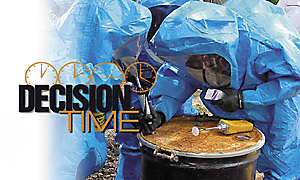
Every year, nearly ten million tons of industrial chemical liquids and gases used in U.S. manufacturing flow through 2.1 million miles of pipelines and across 200,000 miles of railroad track, highways and inland waterways. These toxic industrial chemicals, classified as Toxic Inhalation Hazards, are substances known to pose a danger to humans in the event of a release.
Challenges to first responders
The prevalence of these chemicals presents challenges to first-responder organizations, changing the nature and complexity of emergency situations in specific ways:
These challenges are driving a new approach to response — one far more reliant on information. Here are five ways more, better and faster information is improving response efforts:
1) Sensing & monitoring equipment
Equipment to detect and alert responders to unseen threats has become a life-critical requirement. Effective response solutions must include personal protection and detection tools for rapid broadband detection of — and protection from — chemical vapor and radiological threats, combined with deployable monitoring networks to monitor site perimeters and alert incident commanders to the movement and nature of hazardous vapor clouds.For equipment to be effective, users must be continually trained in safe operation and how to interpret readings, and equipment must be functional and calibrated. Training should include not only operation of equipment in a classroom, but also when trainees are fully suited with respiratory protection, protective suits and multi-layered gloves.
Equipment functionality can be assured by using manufacturer’s bump test or calibration procedures. Automated systems(1) available for auto-calibration, bump testing and charging can ensure that readings are accurate and that equipment is always ready to go.
2) Decision support tools
A bewildering array of possible toxic chemicals may exist at an incident site, making a chaotic situation difficult to manage. The National Fire Protection Association’s Standard for Professional Competence of Responders to Hazardous Materials Incidents 472 suggests that all responders collect physical clues to help identify materials involved in incidents.
New technology has led to the availability of decision support systems(2) that use physically observed characteristics such as colors, textures, gas or liquid, heavier than air, and odors to quickly and systematically identify potential agents involved in an incident. Offering fast, real-time identification and assessment of hazards, the system addresses the unique needs of first responders. An integrated response database consists of more than 91,000 chemical, biological warfare and bioterror agents, trade names and improvised explosive devices.
3) Access to expertise
Once on scene, first responders often realize that they need additional private, state and federal agency expertise. One issue that must be addressed is how to export on-scene information in real-time without relying on voice communication. Best practices call for real-time delivery of data using remote access technology solutions to connect an incident commander’s data screen with remote experts.
The most direct solution today involves using secure data transfer over the Internet. With today’s sophisticated incident command centers and their ability to connect securely to the Internet, one solution is to have remote servers that can aggregate and store sensor data from multiple networks(3) and enable responders to share this real-time data through a secure online interface(4) with experts in remote locations.
4) Who to call?
The Center for Toxicology and Environmental Health (CTEH) based in Little Rock, Ark., is an example of a private rapid-response company. CTEH provides a range of services, including toxicology, risk assessment, industrial hygiene, occupational health, litigation support, and response to emergencies or other events involving release or threat of release of chemicals. Dispatched by corporate jet, CTEH experts can assist local and regional first-responder organizations to quickly assess hazardous situations and define cost-effective and optimized responses to minimize the loss of life and property.5) Retention and reuse of real-time data
Use of sensing and monitoring instruments in a hazardous environment provides valuable real-time data streams. This data can be used for training programs, reviewing response techniques and effectiveness, and can establish key events in a hazmat timeline for reporting and litigation support.From detection to decision
Using information tools in conjunction with the latest sensing and monitoring technologies gives first responders and industrial hygienists the ability to move from detection to decision in a matter of seconds. A comprehensive knowledge base, advanced analytical capabilities, access to expertise and cutting-edge sensing equipment are all central to life-critical decision support and first-response capabilities.
FOOTNOTES: (1) AutoRAE from RAE Systems, Inc. (2) HazRAE from RAE Systems, Inc. (3) AreaRAE networks from RAE Systems, Inc. (4) RAEShare Web-hosted incident data management from RAE Systems, Inc.